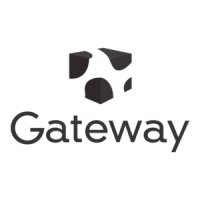
Do you have a question about the Gateway Solo 9500 and is the answer not in the manual?
Details the components and indicators found on the front panel of the Gateway Solo 9500 notebook.
Identifies and describes the ports, ventilation fan, and modular bays located on the left side of the notebook.
Lists and explains the function of various ports and the modular bay on the right side of the notebook.
Details the ports and connectors available on the back panel of the notebook, including serial, parallel, and video outputs.
Illustrates and describes components located on the bottom of the notebook, such as reset hole and modular bays.
Explains how to find essential information like model, serial, and part numbers from the label on the computer's bottom.
Lists optional accessories offered by Gateway, including power adapters, carrying cases, and docking stations.
Introduces HelpSpot as a comprehensive resource for computer information, troubleshooters, and instructional videos.
Details the steps to watch instructional videos within HelpSpot to learn about various computer tasks and concepts.
Explains how to access and use the built-in online help system within software applications for guidance and information.
Guides users to the official Gateway website for accessing technical documentation, product manuals, and support services.
Provides an overview of the Windows desktop, explaining its role as a personalized workspace for performing tasks.
Explains the key elements of the Windows desktop, including the taskbar, Start button, and Recycle Bin icon.
Details how to launch applications, access files, customize the system, and get help using the Start menu.
Describes common window elements such as title bars, menu bars, and control buttons (close, maximize, minimize).
Covers essential file management operations including viewing drives, creating folders, copying, moving, deleting, and browsing.
Explains how to use Windows Search (XP/Me/2000) and Find (98) utilities to locate files based on various criteria.
Details basic document handling tasks: creating, saving, opening, and printing, using Microsoft Word as an example.
Lists useful keyboard shortcuts for common Windows operations like copying, pasting, cutting, and closing windows.
Explains the Internet, its services (email, Web), and requirements like modems and Internet Service Providers (ISPs).
Guides users on how to establish an internet account with an ISP, such as America Online, for internet access.
Covers the procedures for connecting to and disconnecting from an internet account, including America Online.
Introduces the World Wide Web, web pages, browsers, and how to use links (hyperlinks) to navigate content.
Explains how to access specific websites by entering a URL or clicking a link after establishing an internet connection.
Details the process of downloading files from websites, emphasizing virus scanning and file saving procedures.
Covers the fundamentals of e-mail, including sending messages, checking mail, and understanding e-mail addresses.
Explains how to insert and remove diskettes, access files, and handle potential drive issues.
Covers inserting discs into the CD/DVD drive and its basic functions for multimedia playback.
Details how to use the notebook's Audio DJ feature to play CDs independently of the computer's power state.
Guides users on adjusting the overall system volume and specific device volumes in Windows XP using hardware and software controls.
Explains how to play audio CDs using Windows Media Player (XP/Me/2000) and the Windows CD Player (98).
Covers using the Sound Recorder utility to capture audio via microphone and play back recorded files.
Explains how to use the Windows Media Player for playback of various audio and video file formats.
Provides instructions for playing DVD movies using the computer's DVD drive and player software, including regional code considerations.
Details using MusicMatch for playing CDs, creating MP3s, managing music libraries, and listening to Internet radio.
Explains how to connect the notebook to a television using RCA or S-Video cables for external display.
Introduces MGI VideoWave IV for capturing and editing video from external sources via the IEEE 1394 port.
Guides users on configuring personal information for fax headers and cover sheets, which is required by law.
Details the process of sending a fax using PhoneTools, including recipient information and message text.
Explains how to send documents as faxes directly from applications like word processors or spreadsheets.
Covers how PhoneTools receives and stores incoming faxes, and how to view and print them from the Fax Inbox.
Explains how to check the notebook's battery charge level using taskbar icons or status displays.
Describes how the notebook batteries recharge automatically when connected to AC power and the indicator light.
Provides step-by-step instructions for safely removing and replacing the main notebook battery.
Guides users on installing an optional second battery into the notebook's modular bay for extended power.
Offers methods to conserve battery power and utilize alternate sources to maximize runtime.
Explains Standby and Hibernate power-saving modes and how to activate them for efficient battery usage.
Details how to adjust power schemes, alarms, and advanced power settings via the Control Panel for optimal power management.
Explains how to configure Intel SpeedStep technology settings to manage processor speed and conserve battery power.
Covers monitoring battery charge and setting low battery warnings within the Windows NT operating system.
Provides advice on traveling with a modem, including telephone cords, adapters, line testers, and remote access.
Discusses restrictions and guidelines for using wireless devices when traveling internationally, especially on aircraft.
Covers copying files for travel, setting up remote access, and implementing security measures like locking cables and startup passwords.
Explains how to modify display settings like color depth, screen resolution, desktop background, and screen savers.
Details how to customize touchpad sensitivity, pointer speed, button actions, and edge motion for personalized control.
Guides users on assigning custom functions to multi-function keyboard buttons using the dedicated utility software.
Explains how to insert and remove PC Cards (PCMCIA) and the concept of hot-swapping while the notebook is running.
Covers the procedures for swapping modular components in the notebook's bays, such as drives and batteries.
Provides essential safety guidelines and precautions to prevent damage from static electricity when handling internal components.
Guides users on safely adding or replacing SO-DIMM memory modules to upgrade the notebook's RAM.
Details the step-by-step process for removing and replacing the notebook's internal hard drive, including safety measures.
Introduces the port replicator and details its front, left, back, and right side views, showing ports and connectors.
Explains how to attach the notebook to the port replicator, including connecting external devices and aligning connectors.
Introduces the docking station and details its front, left, back, and right side views, identifying ports and features.
Provides steps for docking the notebook, including initial setup, connecting external devices, and securing the connection.
Guides users on enabling external speakers and audio jacks on the docking station, particularly for Windows Me.
Details the process for installing a standard half-length PCI card into the docking station's expansion bay.
Explains the advantages of networking computers, such as sharing internet, drives, peripherals, and playing games.
Introduces the Gateway Connected Home system for networking devices and sharing resources within a household.
Discusses choosing between wired (HPNA, Ethernet) and wireless (WiFi, Bluetooth) network connections based on needs.
Helps users select the appropriate network type by considering connection speeds, cost, and intended usage.
Provides lists of required equipment for setting up HPNA, Ethernet, Wireless Ethernet, and Bluetooth networks.
Covers methods for moving personal data files, settings, peripherals, and software from an old computer to a new one.
Explains how to use the Files and Settings Transfer Wizard to migrate data and preferences to a new Windows XP system.
Describes manual file transfer methods using removable media like diskettes or CDs, or via a home network.
Guides users on locating personal data files, often stored in My Documents, using Windows search tools.
Details how to transfer internet accounts and browser settings, including using the Windows Internet Connection Wizard.
Covers reinstalling printers and scanners, noting differences between older and newer device installation requirements.
Provides guidance on reinstalling previously installed software from original CDs or backup media.
Offers advice on protecting the notebook from physical damage, environmental factors, and improper handling to extend its life.
Explains the process of creating a startup diskette for system recovery in case Windows fails to start properly.
Details how to use antivirus software to scan files, check programs, and maintain protection against the latest threats.
Covers utilities for managing hard drive space, including checking disk space, cleanup, error checking, and defragmentation.
Explains how to recalibrate the battery to ensure accurate charge readings and maintain the battery gauge's precision.
Provides instructions for cleaning the computer's exterior, keyboard, screen, and mouse to maintain optimal performance.
Explains the function of device drivers and provides instructions for reinstalling them for various Windows versions.
Covers reinstalling Windows 98, Me, 2000, or XP using the System Restoration Kit, including driver and program reinstallation.
Details how to reinstall software applications using the System Restoration Kit or original program installation CDs.
Outlines critical safety precautions to follow before and during troubleshooting procedures to prevent injury or damage.
Provides basic checks and initial steps to resolve common computer issues before proceeding to advanced troubleshooting.
Introduces diagnostic tools like PC Doctor and explains how to access them for system information and problem diagnosis.
Addresses common issues with CD/DVD drives, including disc recognition errors and lack of audio output.
Discusses problems arising from new device installations, focusing on IRQ conflicts and freeing system resources.
Covers troubleshooting for unrecognized diskette drives and common error messages like 'Access Denied' or 'Disk is full'.
Addresses issues related to accidentally deleted files and provides steps for restoring them from the Recycle Bin.
Discusses troubleshooting steps for hard drive errors, including 'Insufficient disk space' and 'Data error' messages.
Covers common problems with internet connection, browsing websites, and slow loading speeds, offering solutions.
Addresses problems with external keyboards not working or characters repeating, and display issues like resolution or dim text.
Covers troubleshooting for memory errors and modem connection problems, including dialing properties and diagnostics.
Addresses external mouse problems and issues connecting to company networks, including wireless device operation.
Covers troubleshooting for incorrect password entries, forgotten startup passwords, and PC Card installation problems.
Addresses issues related to the computer not powering on, battery problems, and printer errors like queue full or out of paper.
Covers troubleshooting for ScanDisk, no sound from speakers, and video display problems like dark screens or pixel defects.
Provides recommendations and guidelines for effectively contacting Gateway Technical Support.
Lists contact numbers for various support services, including automated systems, technical assistance, and ISP support.
Recommends resources for hardware and software training, including self-help guides and fee-based tutorial hotlines.
Describes in-person training at Gateway Country stores and online courses available through Learn@Gateway.
Stresses the importance of following all safety instructions marked on the product and in the documentation for safe operation.
Provides essential safety guidelines for setting up the computer system, including placement and ventilation requirements.
Offers advice on safe practices during computer usage, including handling power cords, avoiding spills, and cleaning procedures.
Recommends using only Gateway-approved replacement parts and accessories to ensure system safety and performance.
Presents compliance information for wireless devices, including general guidance, restrictions, and RF exposure limits.
Details FCC Part 15 compliance for intentional and unintentional emitters, including wireless device regulations.
Outlines Industry Canada (IC) requirements for wireless devices and unintentional emitters, including RSS 210 and ICES-003.
Addresses wireless device regulations in Mexico, specifying SCT ID requirements and operational guidelines for devices.
Lists European directives (EMC, Low Voltage, Radio/Telecom) and standards applicable to Information Technology Equipment.
Presents the FCC declaration of conformity for Gateway products, including responsible party and product identification details.
Explains FCC Part 68 rules for modems, covering connection requirements, Ringer Equivalence Number (REN), and telephone company interactions.
Provides safety information regarding laser devices in CD/DVD drives, classifying them as Class 1 Laser Products and warning against misuse.
Index entries covering topics from AC adapter and Accessories to Bluetooth and CD/DVD drive.
Index entries covering topics from Data transfer speed and Deleting files to Jacks and Keyboard.
Index entries covering topics from Kensington lock and Keyboard to Network and Opening files.
Index entries covering topics from Radio and Recycle Bin to Safety and ScanDisk.
Index entries covering topics from Taskbar and Telephone to Volume and Windows.

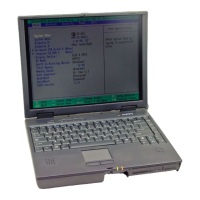
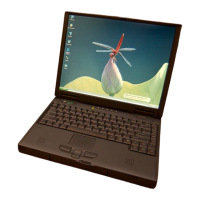



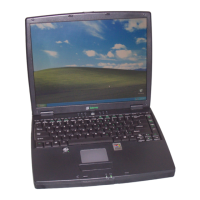
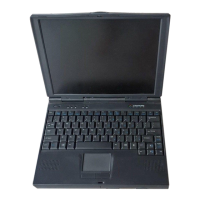


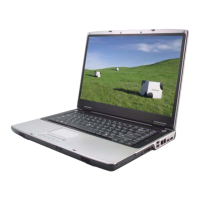

